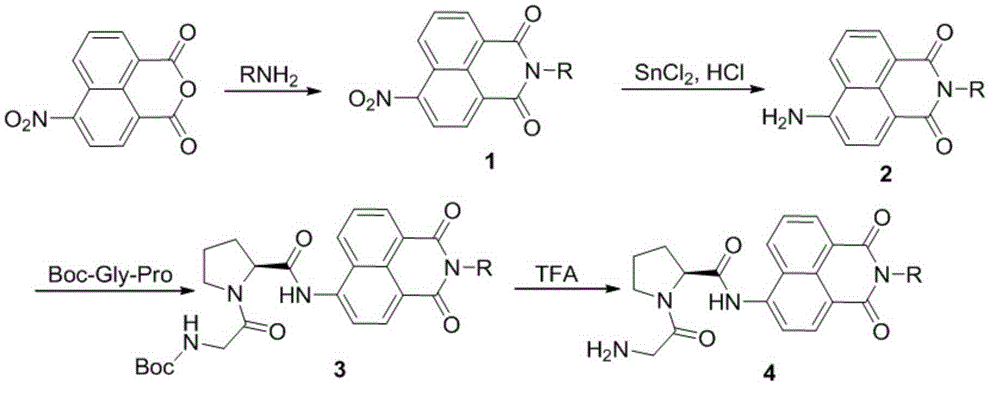Fluorescent probe substrate for testing activity dipeptidyl peptidase IV and application of fluorescent probe substrate
A dipeptidyl peptidase and fluorescent probe technology, applied in the field of biomedicine, can solve the problems of large quantitative error, low selectivity of single enzyme, false positive, etc. The effect of sensitivity
- Summary
- Abstract
- Description
- Claims
- Application Information
AI Technical Summary
Problems solved by technology
Method used
Image
Examples
Embodiment 1
[0041] Synthesis of N-butyl-4-(glycine-proline)-amino-1,8-naphthalimide (GPAN)
[0042] The synthetic route of N-butyl-4-(glycine-proline)-amino-1,8-naphthalimide (GPAN) is as follows figure 2 shown. (1) Synthesis of Compound 1
[0043] At room temperature, add n-butylamine (1.10g, 15mmol) into a solution of 4-nitro-1,8-naphthalene anhydride (2.43g, 10mmol) in acetic acid (50mL), react at 100-110°C overnight, then filter while hot, The filter cake was washed with acetic acid and dried in vacuo to obtain compound 1 as a beige solid with a yield of 45-55%.
[0044] (2) Synthesis of compound 2
[0045] At room temperature, add N-butyl-4-nitro-1,8-naphthalimide (1.49g, 5mmol) and tin dichloride dihydrate (6.77g, 30mmol) into the ethanol (50mL) solution in turn, and stir After uniformity, concentrated hydrochloric acid (10 mL) was slowly added dropwise, and the reaction was completed at room temperature for 30 min. Quench the reaction with 10% sodium carbonate solution (40mL)...
Embodiment 2
[0053] In Vitro Determination of the Selectivity of Human Recombinant DPP-IV Single Enzyme
[0054] (1) Prepare 198 μL DPP-IV metabolic reaction system in advance, including PBS buffer (50 mM) at pH 7.4, recombinant human DPP-IV single enzyme (1 μg / mL), carbonic anhydrase (CA, 10 μg / mL), trypsin (trypsin, 10μg / mL), pepsin (pepsin, 10μg / mL), butyrylcholinesterase (BChE, 10μg / mL), acetylcholinesterase (AChE, 10μg / mL), carboxylesterase (hCE1, hCE2, 10 μg / mL), bovine serum albumin (BSA, 10 μg / mL), human serum albumin (HSA, 10 μg / mL) were shaken and pre-incubated at 37°C for 3 minutes;
[0055] (2) Add 2 μL of GPAN with a concentration of 10 mM to the reaction system to initiate the reaction;
[0056] (3) After 30 minutes, add 200 μL of glacial acetonitrile, shake vigorously, and terminate the reaction;
[0057] (4) Use a high-speed refrigerated centrifuge at 4°C, under the condition of 20,000×g, after high-speed centrifugation for 20 minutes, take the supernatant, and perform fl...
Embodiment 3
[0059] Determination of DPP-IV time standard curve
[0060] The experiment was carried out on a microplate reader using a 96-well plate, GPAN 100 μM, DPP-IV single enzyme 0.1 μg, PBS buffer solution of pH 7.4 50 mM, a total volume of 200 μL, incubated at 37°C for 30 min, and the microplate reader every 5 minutes Analysis, the ratio of the fluorescence intensity of the product to the fluorescence intensity of the substrate and the incubation time to make a standard curve, the R of each standard curve 2 >0.99, indicating that the standard curve has a wide linear range and can accurately quantify the content of DPP-IV ( Figure 5 ).
PUM
 Login to View More
Login to View More Abstract
Description
Claims
Application Information
 Login to View More
Login to View More - R&D
- Intellectual Property
- Life Sciences
- Materials
- Tech Scout
- Unparalleled Data Quality
- Higher Quality Content
- 60% Fewer Hallucinations
Browse by: Latest US Patents, China's latest patents, Technical Efficacy Thesaurus, Application Domain, Technology Topic, Popular Technical Reports.
© 2025 PatSnap. All rights reserved.Legal|Privacy policy|Modern Slavery Act Transparency Statement|Sitemap|About US| Contact US: help@patsnap.com



